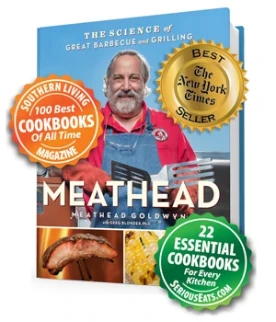I would be grateful if anyone would be able to post pics showing correct probe placement in a spatchcocked turkey. I can do a chicken no problem, but I'm having a little harder time with the turkey.
Announcement
Collapse
No announcement yet.
Proper Probe Placement in Spatchcocked Turkey
Collapse
X
-
Club Member
- Aug 2017
- 7679
-
Primo XL
Weber 26"
Weber 22"
Weber 22"
Weber 18"
Weber Jumbo Joe
Weber Green Smokey Joe (Thanks, Mr. Bones!)
Weber Smokey Joe
Orion Smoker
DigiQ DX2
Slow 'N Sear XL
Arteflame 26.75" Insert
Blaze BLZ-4-NG 32-Inch 4-Burner Built-In
- With Rear Infrared Burner
- With Infrared Sear Burner
- With Rotisserie
Empava 2 Burner Gas Cooktop
Weber Spirit 210
- With Grillgrates
​​​​​​​ - With Rotisserie
Weber Q2200
Blackstone Pizza Oven
Portable propane burners (3)
Propane turkey Fryer
Fire pit grill
-
Thanks! You can't go wrong with Malcolm Reed and it does look pretty easy going vertically.Originally posted by Ricardo View PostGive this a try: https://www.youtube.com/watch?v=9PEAQ_YopGk
Hope this helps.
Comment
-
Club Member
- Apr 2016
- 19271
- Near Richmond VA
-
Weber Performer Deluxe
SNS
Pizza insert
Rotisserie
Cookshack Smokette Elite
2 Thermapens
Chefalarm
Dot
lots of probes.
Fireboard
I suggest that after the the temp of your bird starts to rise, go back and move the probe a bit to make sure it is displaying the lowest temp.
Comment
-
Administrator
- May 2014
- 20065
- Clare, Michigan area
-
Follow me on Instagram, huskeesbarbecue
Smokers / Grills- Yoder loaded Wichita offset smoker
- PBC
- Grilla Silverbac pellet grill
- Slow 'N Sear Deluxe Kamado (SnSK)
- Slow 'N Sear Master Kettle (cart-mounted)
- Slow 'N Sear Travel Kettle
- Masterbuilt Gravity 560
- Weber 22" Original Kettle Premium (copper)
- Weber 26" Original Kettle Premium (light blue)
- Weber Jumbo Joe Gold (18.5")
- Weber Smokey Joe Silver (14.5")
- Traeger Flatrock Griddle
Thermometers- SnS 500 4-probe wireless
- (3) Maverick XR-50 4-probe Wireless Thermometers
- A few straggler Maverick ET-732s
- Maverick ET-735 Bluetooth (in box)
- Smoke X4 by ThermoWorks
- Thermapen MkII, orange & purple
- ThermoPop, yellow, plus a few more in a drawer for gifts
- ThermoWorks ChefAlarm (wife's)
- Morpilot 6-probe wireless
- ThermoWorks Infrared IRK2
- ThermoWorks fridge & freezer therms as well
Accessories- Instant Pot 6qt
- Anova Bluetooth SV
- Kitchen Aide mixer & meat grinder attachment
- Kindling Cracker King (XL)
- a couple BBQ Dragons
- Weber full & half chimneys, Char-Broil Half Time chimney
- Weber grill topper
- Slow 'N Sear Original, XL, and SnS Charcoal Basket (for Jumbo Joe)
- Drip 'N Griddle Pans, 22' Easy Spin Grate, and Elevated Cooking grate, by SnSGrills
- Pittsburgh Digital Moisture Meter
Beverages- Favorite summer beers: Leinenkugels Summer & Grapefruit Shandy, Hamm's, Michelob Ultra Pure Gold & Lime
- Fav other beers: Zombie Dust (an IPA by 3 Floyd's Brewing), Austin Bros IPA, DAB, Sam Adams regular, Third Shift amber or Coors Batch 19, Stella Artois
- Fav cheap beers: Pabst, High Life, Hamm's & Stroh's
- Most favorite beer: The one in your fridge
- Wine: Red - big, bold, tannic & peppery- Petite Sirah, Zinfandel, Cabernet Sauv, Sangiovese, Syrah, etc
- Whiskey: Buffalo Trace, E.H. Taylor, Blanton's, Old Forester 1870, Elijah Craig Toasted. Neat please.
- Scotch: Current favorite- The Arran (anything by them), Glenmorangie 12yr Lasanta, sherry cask finished. The Balvenie Double Wood, also like Oban 18yr, and The Glenlivet Nadurra (Oloroso sherry cask finished) among others. Neat please.
About me
Real name: Aaron
Location: Farwell, Michigan - near Clare (dead center of lower peninsula).
Occupation:- Healthcare- Licensed & Registered Respiratory Therapist (RRT) at MyMichigan Health, a University of Michigan Health System.
Do you only have 1 meat probe? If so I'd just place it in the center-most point of the breast. Hard to tell exactly, but with a good eye you can get close. The breast is what you don't want to overcook, 150-155 is good, 160 absolute max. The legs/thighs, who cares, they're good at 170-190. Me, I prefer dark meat up there at 180-190. If you have 2, put one in the leg/thigh or other breast to be extra safe. If you have an instant read, then you can spot check the dark meat as needed.
Comment
-
I ended up doing this for my first time out. It seemed to be cooking fast and sure enough a little movement brought the temp down to where I thought it should be.Originally posted by RonB View PostI suggest that after the the temp of your bird starts to rise, go back and move the probe a bit to make sure it is displaying the lowest temp.
Comment
-
For some reason trying to get the center of the breast horizontally was a little tricky. This was my first turkey and it all looks a little different when spatchcocked. Placing the probe vertically is the way for me to go. I'll try another probe in the thigh. I'm with you on this about if the breast is done the legs and thighs take care of themselves.Originally posted by Huskee View PostDo you only have 1 meat probe? If so I'd just place it in the center-most point of the breast. Hard to tell exactly, but with a good eye you can get close. The breast is what you don't want to overcook, 150-155 is good, 160 absolute max. The legs/thighs, who cares, they're good at 170-190. Me, I prefer dark meat up there at 180-190. If you have 2, put one in the leg/thigh or other breast to be extra safe. If you have an instant read, then you can spot check the dark meat as needed.
Good tip about 150 - 155 because I went to 160 (and the probe was probably placed a little too close to the bone) and I was surprised at the carryover after cooking at 325.
Comment
-
It's also a good idea in my opinion halfway through the cook (more or less) to go out and move the probe in a little deeper to see if the temp changes, then pull it out a little to see if it changes. Wherever you get the lower reading, leave it there. That will sorta help you determine where is the deepest point, but it only works after it's been cooking so that the outer layers are warmer. That's what I do w/ chicken or turkey a couple times during the cook.
-
Announcement
Collapse
No announcement yet.








Comment